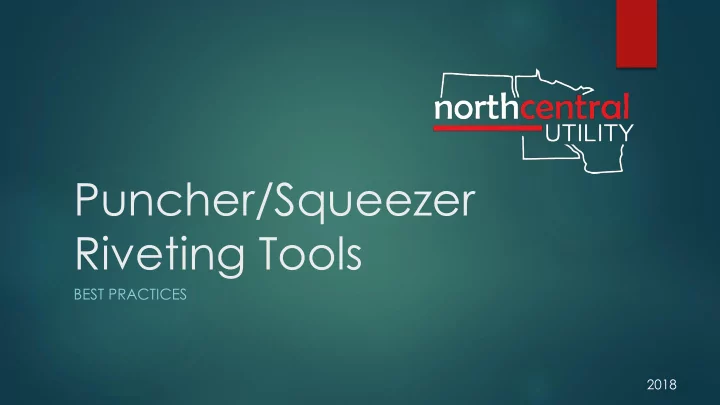

Puncher/Squeezer Riveting Tools BEST PRACTICES 2018
Tool Uses Top Rail Punch Top Rail Punch Punching holes in top roof rails Top Rail Squeezer Top Rail Squeezer Setting rivets to connect top rail Bottom Rail Squeezer Setting rivets to connect bottom rail Bottom Rail Squeezer
Advantages vs. Drilling Reduces Noise Near perfect holes every time Increases efficiency Less operator fatigue
Best Practice - Tooling Inspection Set-up Operation Storage
Inspect Before Use Safety glasses are required Check to see hose has no damage Check that all connections are tight Know your surroundings and who else is in the shop
Set-Up Plug in air hose Turn air on Mark the hole your going to punch Air Hose Plug In
Punching Hole Keep Finger off trigger until you are going to use tool Hold tool with tight grip Line up puncher with where you want the hole Pull trigger, then take finger away from trigger Keep a tight grip on tool until you set it down Disconnect the air hose
Setting Rivet ► Place rivet in hole pounding through with hammer if necessary ► Hold the rail squeezer with a tight grip ► Line up the rail squeezer with the rivet ► Pull the trigger then take finger off trigger ► Set down tool and unplug air hose ► Check the rivet to ensure its set tightly Line Up With Rivet
Setting Rivet Video
Watch Out For… Keep fingers away from squeezer Be careful of dropping the tools (very heavy) Don’t punch where caulking is (gets stuck in puncher) Watch for possible metal debris (wear safety glasses)
Maintenance Add WD40 to oil holes in both squeezer and setter after use Oil Holes
Tool Storage Wipe off tools with clean rag Wrap up hoses Keep Puncher and Squeezers dry Don’t set tools where they can be easily knocked off a ledge
Training Training Quiz https://www.flexiquiz.com/SC/N/d2e503f7-47c4-42e1-9ffc- 95f9a4c11bb4
Recommend
More recommend